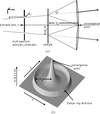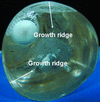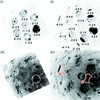issue contents
April 2010 issue

Cover illustration: PDB_REDO optimization of the oldest structure with experimental data in the PDB [155c; Timkovich & Dickerson (1976). J. Biol. Chem. 251, 4033-4046]. Front: final structure - warmer colours show greater atomic displacement. Back: final structure model with atomic trajectories in yellow. Courtesy of Joosten et al. [J. Appl. Cryst. (2009), 42, 376-384].
research papers
The main crystallographic properties of the cross-correlation function between an electron-density map and its model are described, together with its first applications.
The local atomic order of nanocrystalline pure ZrO2 powders exhibiting the tetragonal phase, synthesized by different wet-chemical routes, has been investigated by extended X-ray absorption fine structure spectroscopy (EXAFS). It was found that the crystallographic model widely accepted for the tetragonal phase does not fit the EXAFS data and, thus, alternative models were explored.
A simple but effective protocol by which to prepare monodispersed protein standards for molecular mass determinations by small-angle X-ray scattering is described.
The small-angle X-ray scattering data of expanded fluid mercury in the critical region and the metal–nonmetal transition have been interpreted in terms of a two-phase system. The results shed new light on the structure of mercury in this region.
The method of computing reciprocal-space planes containing diffuse scattering patterns from a model crystal using lots has been extended to include magnetic scattering. A speed increase of at least an order of magnitude is obtained when performing these computations on currently available graphics processing units.
A model is described which allows the azimuthal X-ray diffraction pattern to be calculated for any hkl reflection of tracheid cells in any orientation. The same description can also be applied to fibers with an additional level of organization, e.g. twisted fibers.
A new method of acquiring powder diffraction data by translation rather than rotation of the detector is described. Initial experimental data are presented and further applications of the approach discussed.
A system of one-, two- and three-dimensional metrically independent relations between the squared moduli of reciprocal-lattice vectors (Q values) is developed. The relations generalize and thereby resolve the earlier special Runge–de Wolff approach to indexing unknown powder patterns.
The twin structure of a near-stoichiometric lithium niobate single crystal was observed and analyzed by transmission synchrotron topography. The formation mechanism of these twins is discussed.
The background remaining in energy-filtered convergent-beam electron diffraction (CBED) patterns is composed of a slowly varying diffuse component and a signal of much higher angular frequency that mimics the distribution of the elastic signal within each reflection. A model for this background is proposed and verified by a differential analysis of some experimental energy-filtered CBED patterns. This work paves the way for a new approach to quantitative CBED.
Methods for studying simulated modulated protein crystals via supercells were evaluated using existing protein crystallographic software packages.
A silicon crystal has been designed for application in both triple Laue interferometry and double Laue diffractometry and its (220) lattice-plane spacing has been calibrated by combined X-ray and optical interferometry to within a 5 × 10−9 relative uncertainty.
An effective approach to collecting high-pressure X-ray total scattering data yielding high-resolution pair distribution functions for samples within a diamond anvil cell is presented, which takes into account the parallel optimization of beamline configuration, pressure-cell parameters and data reduction.
Download citation


Download citation


Large-sized monoclinic LaVO4 crystals have been successfully obtained in the Czochralski method by employing proper seeds to suppress the severe bulk spiral growth. A triggering mechanism has also been proposed to account for the influence of seeds on the bulk spiral formation, a problem that is becoming increasingly urgent in growing low-symmetry oxide crystals.
Download citation


Download citation


A series of cobalt-exchanged hydroxyapatite (CoHAp) powders with different Ca/Co ratios and nominal unit-cell contents Ca10−xCox(PO4)6(OH)2, x = 0, 0.5, 1.0, 1.5 and 2.0, were synthesized by hydrothermal treatment of a precipitate at 473 K for 8 h. The effects of cobalt content on the CoHAp powders were investigated using inductively coupled plasma emission spectroscopy, particle size analysis, transmission electron microscopy and high-resolution transmission electron microscopy analyses, as well as X-ray powder diffraction including Rietveld analysis.
Download citation


Download citation


The structure of the 2:1 compound in the system methanol–ammonia has been determined from high-resolution neutron powder diffraction; the methyl groups are found to be orientationally ordered at 4.2 K but become disordered at 180 K.
The design of a light-emitting diode array device suitable for use in single-crystal X-ray photocrystallographic experiments is presented, together with a description of the experimental methodology employed in these experiments.
cryocrystallography papers
A new semi-automated protein crystal mounting device has been developed for the capillary-top mounting method, which has advantages for the sulfur single-wavelength anomalous diffraction phasing method using longer-wavelength X-rays.
short communications
The characteristic features of the small-angle scattering (SAS) correlation function of long cylinders with oval right section are described.
It is demonstrated that diffraction gratings can be used as accurate momentum-transfer calibration standards in small-angle X-ray scattering experiments.
computer programs
CONEX, a program for angular calibration and averaging of two-dimensional powder scattering patterns
CONEX is a Windows application for converting X-ray powder patterns measured on flat two-dimensional detectors into one-dimensional scattering patterns. It is based on the rigorous use of calibration samples to determine the three-dimensional position of the detector, which enables one to correct the data for geometrical distortions, even when the detector is highly tilted and not centered on the beam.
By contouring the density resulting from the summation of pseudo-Gaussian atoms an approximation to the Lee–Richards surface of a molecule can be computed in linear time, allowing rapid identification of surface atoms and residues. This allows accurate calculation of molecular surface areas and rendering of approximate molecular surfaces to be extended to larger macromolecules than is currently feasible.
Open  access
access
 access
accessThe new web-based application WebCSD is introduced, which provides a range of facilities for searching the Cambridge Structural Database within a standard web browser. Search options within WebCSD include two-dimensional substructure, molecular similarity, text/numeric and reduced cell searching.
AMINONET is a Java-based software tool to construct and visualize different protein contact networks (unweighted and weighted; long range, short range and any range; hydrophobic, hydrophilic, charged or all-amino-acid networks). The software will also help in calculating the values of the different topological parameters of the constructed networks to understand the structure–function relationship.
Download citation


Download citation


This article describes the computer program PSSP (powder structure solution program) and the related simulated annealing-based methodology used for the crystal structure determination of molecular solids from X-ray powder diffraction data.
laboratory notes
A robotic sample changer has been designed and built to be used for neutron powder diffraction experiments at the Australian OPAL research reactor.


 journal menu
journal menu














































